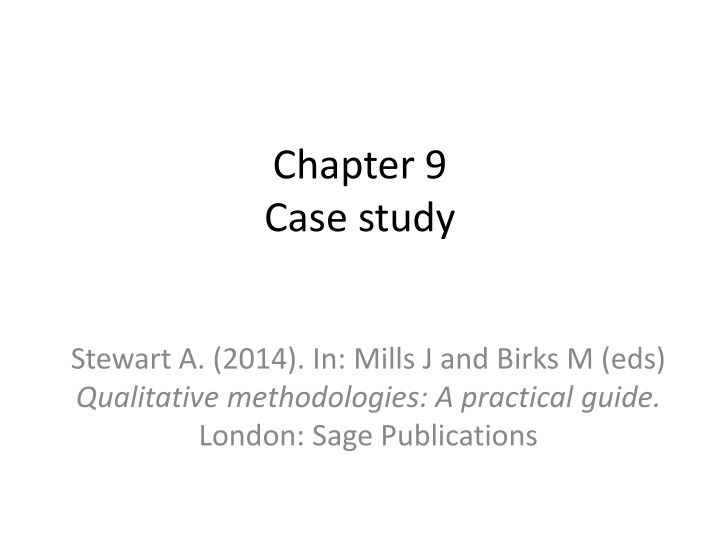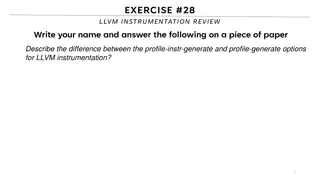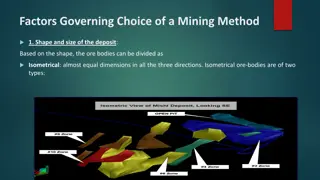Indian Rare Earths Ltd., Kollam – Mining Industry Profile
Indian Rare Earths Ltd. (IREL) in Kollam, under the Atomic Energy of India, is a significant mining industry. Situated in Kerala, known as "God's Own Country," the company is rich in heavy deposits of ilmenite, rutile, zircon, monazite, and sillimanite. IREL specializes in the production and supply of various mineral products, including ilmenite, rutile, zircon, and more, each with specific applications in industries like pigments, ceramics, refractories, and welding electrodes. The company also focuses on energy conservation opportunities, as seen through its Fluidised Bed Dryer system and principles of operation. Explore the diverse product range and the magnetic properties of sand components associated with IREL's operations.
Download Presentation

Please find below an Image/Link to download the presentation.
The content on the website is provided AS IS for your information and personal use only. It may not be sold, licensed, or shared on other websites without obtaining consent from the author.If you encounter any issues during the download, it is possible that the publisher has removed the file from their server.
You are allowed to download the files provided on this website for personal or commercial use, subject to the condition that they are used lawfully. All files are the property of their respective owners.
The content on the website is provided AS IS for your information and personal use only. It may not be sold, licensed, or shared on other websites without obtaining consent from the author.
E N D
Presentation Transcript
Chapter 9 Case study Stewart A. (2014). In: Mills J and Birks M (eds) Qualitative methodologies: A practical guide. London: Sage Publications
Learning objectives Discuss the background and philosophical foundations of case study research Outline the benefits and issues associated with using case study as a methodology Describe the key requirements for collecting and analysing case study data Demonstrate how case study research can be effectively presented and disseminated
History of the methodology Case study an intensive study that provides an in-depth picture of a unit of study (i.e. a person, group, organization, social situation) Early 19thcentury - suggestion that Charles Darwin s biography is an example of a case study (Smith, 1994) Early 20thcentury social workers case histories and Chicago School of Sociology; linked to field of anthropology and ethnomethodology
History of the methodology May be applied in contexts such as law, economics, history, sociology, politics, urban planning, education, public administration Regardless of context focus remains on unit of investigation not on the methodological execution of a set of methods May be single site or multiple site studies
History of the methodology Viewed with scepticism as a research methodology Unable to generalise as only few examples of the phenomenon are studied Case study is generalizable insofar as it provides clear illustration of generalizability of a theoretical construct (Yin, 2003)
History of the methodology Can be used in both qualitative and quantitative research studies Qualitative case study can be used to inform quantitative studies Quantitative and qualitative case studies can be combined in a mixed-methods strategy
Philosophical underpinnings Case study methodology can use numerous methods and accompanying philosophical positions For example: an interpretivist approach may emphasize participant-observation a realist approach may emphasize regular surveys of a particular research site
Philosophical underpinnings Most important consideration is that your selected methods correspond to your ontological and epistemological beliefs
Positioning of the researcher Case study does not predispose the researcher to a particular philosophy or methods It is up to the researcher to identify their philosophical viewpoint beliefs about the world and the nature of knowledge
Aligning philosophy and methodology with purpose Case studies are useful for answering how and why questions Allow for in-depth exploration and interaction with participants Important to consider your research question before choosing a methodology
Aligning philosophy and methodology with purpose Choosing a method before defining the research question is akin to selecting a route to get from point A to B before deciding whether to take a train, bus, or boat; instead, the method of travel will determine the route that should be taken (it would be difficult to take a train along a waterway)
Data generation and collection Requires detailed planning and preparation Negotiating access to case study site can be a multi-layered and time-consuming process Need to consider the implications of data generation and collection methods to be used and how to prepare them Often a good idea to conduct a pilot study to test data collection tools
Data generation and collection Prepare for day 1 on the site as you would prepare for the first day of a new job Know where you are going, whom you are going to meet on arrival and what time you are expected Showing up without notice is akin to showing up to a job without a contract
Data generation and collection Record details regarding research methods used during the study For example, if conducting interviews, record: name of people you interview participants position within the unit date of interview name of recoding file
Analysis of data The type of data generation and collection method will often dictate the analytical approach If conducting interviews you may use qualitative software to analyze transcripts or use fieldnotes taken during interviews as a primary data source
Analysis of data Analysis should proceed systematically A process of analysis that accounts for researcher bias Maintain detailed records of how you conduct your analysis this avoids having to remember how you did it when you are writing up your study
Analysis of data Important to conduct same analysis on data from multiple case studies Conducting same analysis from multiple case studies provides opportunity for comparison across sites Important to identify and account for data sources from different sites
Analysis of data May be easier to recall what was done when simultaneously writing up analysis Writing up while analyzing may result in writing conclusions before completing the analysis Start with a clear outline of how findings will be presented
Quality and rigour Pose the following questions when judging the quality of your study: Have you conducted your research in a systematic way? Does the story that you tell make sense? Does your evidence support your story? Is there any other story that could equally well be told with the data? Have you shown something new? (Maylor and Blackmon, 2005)
Presentation and dissemination of findings Precedents depending on methods include: ethnographic or observational methods commonly use a narrative method with many quotes use of quantitative data more likely to use graphics to display findings
Presentation and dissemination of findings Look for studies that have used similar methods and consider which journals they are published in Submit manuscripts to journals open to case study approaches
Summary One of the most widely used approaches in qualitative research Useful to answer how and why questions about complex phenomena Researcher s philosophical position and the research question will guide choice of methods With good planning, good execution and systematic analysis, case study can be a valuable approach to qualitative research
References Maylor H and Blackmon K. (2005) Researching Business and Management, New York: Palgrave MacMillan. Smith L. (1994) Biographical method. In: Denzin N and Lincoln Y (eds) Handbook of Qualitative Research. Thousand Oaks: Sage, 286-305. Yin R. (2003) Case Study Research: Design and Methods, London: Sage Publication.























